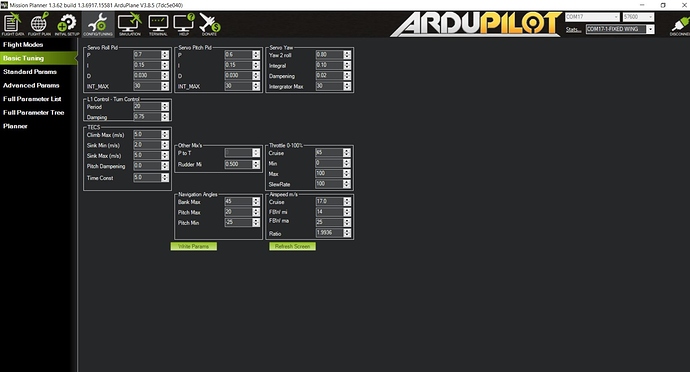Hello Guys, its been a while i work on our Nimbus from foxtech.
replace servos on wing and tail control surfaces. I was reading all through out the conversation.
Its fun sharing ideas and parameters.
For us i like to share ours.
AHRS_EKF_TYPE,2 - 2
ARSPD_FBW_MAX,18 - 25 (good max speed for this type/size of plane)
ARSPD_FBW_MIN,11 - 14 (Just above the stall speed of 10m/s)
LAND_DISARMDELAY,10 - 20sec
LIM_PITCH_MAX,2000 - 2000 (no need to pitch up more than 20°)
LIM_PITCH_MIN,-1500 - -2500 (no need to pitch down more than 15°)
LIM_ROLL_CD,4500 - 4500 (Limits bank angle for heavy plane)
MIXING_GAIN,0.5 - 0.5
MNT_RC_IN_TILT,0 - 0 (for our camera gimbal)
PTCH2SRV_D,0.04 - 0.03 (increased for tighter tune)
PTCH2SRV_FF,0.4 - 0.4
PTCH2SRV_I,0.15 - 0.15 (increased for tighter tune)
PTCH2SRV_IMAX,3000 - 3000
PTCH2SRV_P,0.7 - 0.6 (increased for tighter tune)
PTCH2SRV_RLL,1.15 - 1 (keeps nose more level in turns, less loss of height)
Q_ANGLE_MAX,3000 - 3000
Q_ASSIST_ANGLE,30 - 30
Q_ASSIST_SPEED,0 - 0
Q_TILT_MAX,60 - 45
Q_TILT_RATE_DN,50 - 50
Q_TILT_RATE_UP,200 - 200
Q_TILT_TYPE,2 - 2
Q_TILT_YAW_ANGLE,13 - 13
Q_TRAN_PIT_MAX,10 - 3 (default of 3 resulted in a worrying dip/loss of altitude during transition
Q_TRANS_DECEL,2 - 2
Q_TRANSITION_MS,3000 - 4000 (changed from 5 secs, plane transitions quickly so 5 secs seemed too long)
Q_VFWD_GAIN,0.05 - 0 <----??? (Wind resistance in hover)
Q_WP_RADIUS,500 (now 200, use 400?) - 500 (looser waypoint radius)
Q_WVANE_GAIN,0.2 - 0 <----??? (wind vane enable)
Q_WVANE_MINROLL,2 - 1 (activate on 2 deg of roll)
RLL2SRV_D,0.1 - 0.03 (increased for tighter tune)
RLL2SRV_FF,0.4 - 0.4
RLL2SRV_I,0.2 - 0.15 (increased for tighter tune)
RLL2SRV_IMAX,3000 - 3000
RLL2SRV_P,1 - 0.7 (increased for tighter tune)
RLL2SRV_RMAX,0 - 0
WP_LOITER_RAD,80 - 60 (good distance for QRTL transition, allows plane to slow down enough)
WP_MAX_RADIUS,0 - 0
WP_RADIUS,10 - 30 (more accurate waypoints, especially with flying grids)
YAW2SRV_DAMP,0.08 - 0.02 (tuning to stop tail wag)
YAW2SRV_IMAX,3000 - 3000
YAW2SRV_INT,0.3 - 0.1 (tuning to stop tail wag)
YAW2SRV_RLL,0.8 - 0.8 (tuning to stop tail wag)
YAW2SRV_SLIP,0 - 0
i was able to get @GregCovey and @Graham_Dyer comparing there para. Our nimbus is V1 with 13" on front, 14" on the rear motor.
also ive notice that or AUX1 which suppose to be Right Servo is on the Left side. Is this how Foxtech set up is?
Thanks guys. hope to share mo details when i test today



